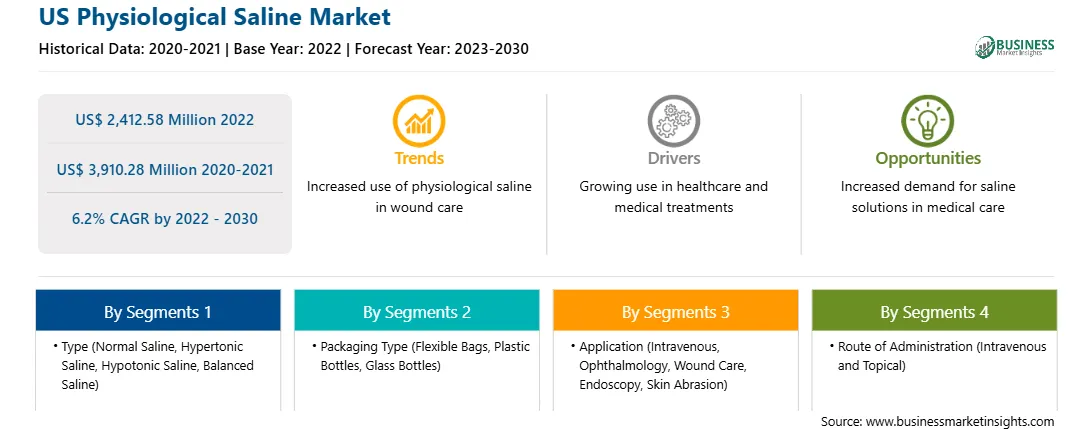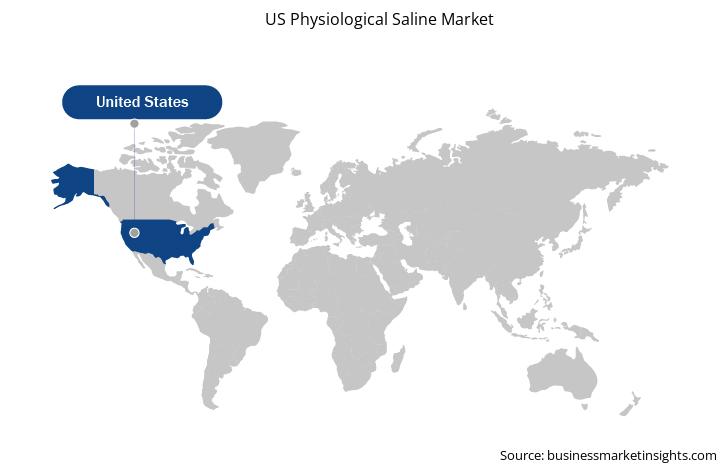The physiological saline market was valued at US$ 2,412.58 million in 2022 and is projected to reach US$ 3,910.28 million by 2030; it is estimated to register a CAGR of 6.2% from 2022 to 2030.
The rising prevalence of serious illnesses, fluid electrolyte disorders, and surging demand for fluid electrolytes in the elderly population are among the factors contributing to the growing physiological saline market size. However, the adverse effects of rapid isotonic saline infusion hinder the growth of the physiological saline market.
A physiological saline solution is composed of isotonic salt solutions with the same pH. An example of a physiological saline solution is Ringer's solution, composed of sodium chloride (NaCl), sodium bicarbonate, and potassium chloride solution. The physician recommends the physiological solution in case of dehydration, fluid imbalances, and many more clinical abnormalities among the patients.
Market Opportunity
Rapid Sample Transportation Using Low-Cost Saline Solutions
A less expensive and readily available saline solution can transport testing samples, enabling more effective, safe, long-distance transportation of samples to diagnostic labs. A readily available saline solution such as "Phosphate Buffered Saline," a simple salt solution commonly available in hospitals and clinical laboratories, was used as a transport medium for coronavirus-contaminated specimens; the saline could keep the samples stable for up to 18 hours. During the COVID-19 pandemic, a shortage of viral transport media posed a major challenge in transporting specimens obtained from COVID-19 patients to diagnostics and testing labs, resulting in an upsurge in demand for sterile saline solutions. As a result, researchers recommended using inexpensive and commonly available salt solutions, such as phosphate-buffered saline solutions, for transportation. Therefore, the rising awareness of less expensive and readily available saline solutions and their use in transporting medical specimens will likely provide opportunities to the US physiological saline market during 2022-2030.
Segmental Analysis
Type-Based Insights
By type, the US physiological saline market is segmented into normal saline, hypertonic saline, hypotonic saline, and balanced saline. The normal saline segment held the largest market share in 2022, and the same segment is anticipated to register the highest CAGR during 2022-2030. Normal saline (NS) comprises a sterile salt solution used for short-term fluid replacement, as it helps restore electrolyte/salt levels in the body. It is a 0.9% sodium chloride solution intended to treat dehydration and electrolyte disturbances among people. NS is a cornerstone of intravenous solutions commonly used in clinical settings. It is suitable for both pediatric and adult patient populations. Primary indications for the use of NS solutions that are approved by the Food and Drug Administration (FDA) are as follows:
- Extracellular fluid replacement to treat dehydration, hypovolemia, hemorrhage, sepsis, etc.
- Treatment of metabolic alkalosis in the presence of fluid loss
- Mild sodium depletion
Further, NS can only be administered through intravenous access, and normal saline management requires evaluating the patient's health status. Pharmacists need to monitor the implementation of IV fluids while installing and recommending orders based on the patient's clinical situation with proper counseling to the nursing department in the hospital regarding dosage and administration.
Packaging Type-Based Insights
The US physiological saline market, by packaging type, is segmented into flexible bags, plastic bottles, and glass bottles. The plastic bottles segment held a larger market share in 2022, and the flexible bag segment is anticipated to register the highest CAGR during the forecast period. Sodium chloride (NaCl) USP solutions for injections are sterile and nonpyrogenic. They are parenteral solutions containing various NaCl concentrations in water for injection (WFI) intended for intravenous (IV) administration. Further, the flexible container is fabricated from a specially formulated polyvinyl chloride. However, solutions coming in contact with plastic containers might leach out certain chemical components from the plastic in very small amounts. Further, biological testing proves effective in supporting the safety of plastic container materials. Therefore, the plastic bottles segment is expected to account for the smallest share of the physiological saline market during the forecast period.
Application-Based Insights
By application, the US physiological saline market is segmented as intravenous, ophthalmology, wound care, endoscopy, skin abrasion, and others. The intravenous segment held a larger market share in 2022, and the same segment is anticipated to register the highest CAGR during the forecast period. Intravenous (IV) saline solutions are formulated to prevent or treat dehydration. Physicians of all ages prescribe IV saline for people who are injured, sick, dehydrated, or undergoing surgery. Saline IV bags provide a rapid, targeted solution to replenish fluids and relieve symptoms.
Furthermore, a combination of sterile water and sodium chloride, or salt and normal saline IVs, helps restore fluid balance and hydrate tissues among patients. IV saline is commonly administered to patient's bloodstreams when they require hydration. It is suitable for people with allergies or sensitivities to specific medications.
Various companies are producing innovative products related to IV saline; for example, Fresenius Kabi USA offers "freeflex" and "freeflex+ IV bags." These products also provide leak prevention, sterility protection, and needle-stick prevention.
Route of Administration-Based Insights
The US physiological saline market, by route of administration, is bifurcated into intravenous and topical. The intravenous segment held a larger market share in 2022, and the same segment is anticipated to register the highest CAGR during the forecast period. IV saline solutions are specially formulated liquids that are injected into a vein to prevent and treat dehydration. Also, these IV fluids are utilized among people of all ages suffering from sickness, injury, dehydration, etc. The IV saline solution is a simple, safe, and common procedure with a low risk of complications. Also, fluid resuscitation is a vital component for managing acutely ill patients, and normal saline is considered the most widely used IV fluid for seriously ill or injured patients. Being a common, simple, and safe procedure, patients administered via the IV route may feel relief quickly.
Strategic insights for the US Physiological Saline provides data-driven analysis of the industry landscape, including current trends, key players, and regional nuances. These insights offer actionable recommendations, enabling readers to differentiate themselves from competitors by identifying untapped segments or developing unique value propositions. Leveraging data analytics, these insights help industry players anticipate the market shifts, whether investors, manufacturers, or other stakeholders. A future-oriented perspective is essential, helping stakeholders anticipate market shifts and position themselves for long-term success in this dynamic region. Ultimately, effective strategic insights empower readers to make informed decisions that drive profitability and achieve their business objectives within the market.

| Report Attribute | Details |
|---|---|
| Market size in 2022 | US$ 2,412.58 Million |
| Market Size by 2030 | US$ 3,910.28 Million |
| Global CAGR (2022 - 2030) | 6.2% |
| Historical Data | 2020-2021 |
| Forecast period | 2023-2030 |
| Segments Covered |
By Type
|
| Regions and Countries Covered | United States
|
| Market leaders and key company profiles |
The geographic scope of the US Physiological Saline refers to the specific areas in which a business operates and competes. Understanding local distinctions, such as diverse consumer preferences (e.g., demand for specific plug types or battery backup durations), varying economic conditions, and regulatory environments, is crucial for tailoring strategies to specific markets. Businesses can expand their reach by identifying underserved areas or adapting their offerings to meet local demands. A clear market focus allows for more effective resource allocation, targeted marketing campaigns, and better positioning against local competitors, ultimately driving growth in those targeted areas.

The List of Companies - US Physiological Saline Market
- Fresenius Kabi AG??? ??
- Merck KGaA?????????????? ??
- AdipoGen Life Sciences Inc?? ??
- Enzo Life Sciences Inc???????????? ??
- ICU Medical Inc???????? ??
- Grifols SA???? ??
- Geno Technology Inc????????????? ??
- B Braun Medical Inc ??
- Pfizer Inc????? ??
- Ward\'s Science
The US Physiological Saline Market is valued at US$ 2,412.58 Million in 2022, it is projected to reach US$ 3,910.28 Million by 2030.
As per our report US Physiological Saline Market, the market size is valued at US$ 2,412.58 Million in 2022, projecting it to reach US$ 3,910.28 Million by 2030. This translates to a CAGR of approximately 6.2% during the forecast period.
The US Physiological Saline Market report typically cover these key segments-
The historic period, base year, and forecast period can vary slightly depending on the specific market research report. However, for the US Physiological Saline Market report:
The US Physiological Saline Market is populated by several key players, each contributing to its growth and innovation. Some of the major players include:
The US Physiological Saline Market report is valuable for diverse stakeholders, including:
Essentially, anyone involved in or considering involvement in the US Physiological Saline Market value chain can benefit from the information contained in a comprehensive market report.